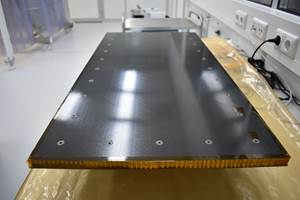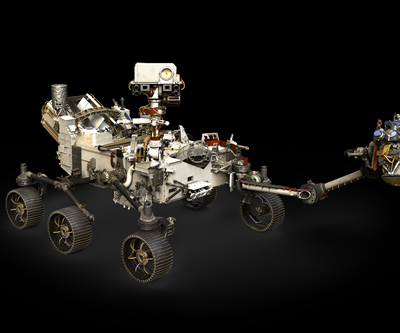Composites-intensive Perseverance rover makes Jezero Crater milestone
Since its landing on Mars in 2021, NASA’s rover has completed four scientific campaigns. Its fifth campaign up to the crater rim, a location of geologic interest, will further aid scientists’ understanding of Mars’ past formation.
NASA’s Perseverance Mars rover used its right-front navigation camera to capture this first view over the rim of Jezero Crater on Dec. 10th, 2024. Source | NASA/JPL-Caltech
As of this December, NASA’s (Washington, D.C., U.S.) Perseverance Mars rover has crested the top of Jezero Crater’s rim at a location the science team calls “Lookout Hill” and is rolling toward its first science stop after the monthslong climb. Taking about 3.5 months and ascending 1,640 vertical feet, the rover has climbed 20% grades, making stops along the way for science observations.
The rover, supported by numerous composite materials and structures, landed in Jezero in February 2021. Since then, Perseverance has completed four science campaigns: the “Crater Floor,” “Fan Front,” “Upper Fan,” and “Margin Unit.” The science team is calling Perseverance’s fifth campaign the “Northern Rim” because its route covers the northern part of the southwestern section of Jezero’s rim. Over the first year of the Northern Rim campaign, the rover is expected to visit as many as four sites of geologic interest, take several samples and drive about 4 miles.
“During the Jezero Crater rim climb, our rover drivers have done an amazing job negotiating some of the toughest terrain we’ve encountered since landing,” says Steven Lee, deputy project manager for Perseverance at NASA’s Jet Propulsion Laboratory in Southern California. “They developed innovative approaches to overcome these challenges — even tried driving backward to see if it would help — and the rover has come through it all like a champ. Perseverance is ‘go’ for everything the science team wants to throw at it during this next science campaign.”
According to Ken Farley, project scientist for Perseverance at Caltech in Pasadena, the Northern Rim campaign brings the rover team new scientific riches as it roves into fundamentally new geology. “It marks our transition from rocks that partially filled Jezero Crater when it was formed by a massive impact about 3.9 billion years ago to rocks from deep down inside Mars that were thrown upward to form the crater rim after impact,” Farley says. “These rocks represent pieces of early Martian crust and are among the oldest rocks found anywhere in the solar system. Investigating them could help us understand what Mars — and our own planet — may have looked like in the beginning.”
With Lookout Hill in its rearview mirror, Perseverance is headed to a scientifically significant rocky outcrop about 1,500 feet down the other side of the rim that the science team calls “Witch Hazel Hill.”
“The campaign starts off with a bang because Witch Hazel Hill represents over 330 feet of layered outcrop, where each layer is like a page in the book of Martian history. As we drive down the hill, we will be going back in time, investigating the ancient environments of Mars recorded in the crater rim,” says Candice Bedford, a Perseverance scientist from Purdue University in West Layfette, Indiana. “Then, after a steep descent, we take our first turns of the wheel away from the crater rim toward ‘Lac de Charmes,’ about 2 miles south.”
Lac de Charmes intrigues the science team because, being located on the plains beyond the rim, it is less likely to have been significantly affected by the formation of Jezero Crater.
After leaving Lac de Charmes, the rover will traverse about a mile back to the rim to investigate an outcrop of large blocks known as megabreccia. These blocks may represent ancient bedrock broken up during the Isidis impact, a planet-altering event that likely excavated deep into the Martian crust as it created an impact basin some 745 miles wide, 3.9 billion years in the past.
Related Content
HyImpulse, Adamant Composites linerless CFRP tank passes hydrostatic burst test
The liquid oxygen (LOX) tank, to be used in a HyImpulse smallsat launch vehicle, demonstrates the ability to withstand pressures well beyond the limits of its intended use.
Read MoreHigh-temperature composite 3D printing facilitates design, manufacture of deployable space structures
Opterus R&D employs an AON3D printer and OOA prepregs to build the tooling, prototypes and end-use versions of its foldable CFRP satellite structures.
Read MoreNanomaterials optimize performance of space-ready carbon fiber composite panels
A recent ESA project led by Adamant Composites aimed to mature nanomaterial-enhanced CFRP for lighter weight, more thermally and electrically conductive materials for manufacturing satellite structures.
Read MoreNew GTL breakthrough in composite tubing for liquid hydrogen in aircraft and space vehicles
Tests versus stainless steel tubing show 10 times faster chill down, fuel flow in 2 seconds and less boil-off for significantly faster fueling and refueling of LH2-powered space vehicles, aircraft and trucks.
Read MoreRead Next
Composites training firm lends a hand with Mars rover
Advanced Composites Training helps train NASA engineers in the use of composite materials for construction of the Mars 2020 rover.
Read MoreIntuitive Machines debuts moon buggy for Artemis program
IM’s Moon RACER is one of three lunar terrain vehicle (LTV) designs being considered by NASA for future operations on the lunar surface.
Read MoreAnalySwift receives NASA STTR contract to enable second-use spacecraft infrastructure
Together with Purdue, AnalySwift aims to develop a composite heater layer and a novel software tool or module to achieve assembly, disassembly of thermoplastic composite joints in space during long-duration missions.
Read More



























